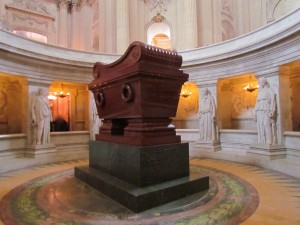Yesterday was our first day in Paris. After settling into our apartment on Rue Bonaparte a few blocks from the Seine, we walked to Les Invalides, Napoleon I’s burial site. During the mile-long walk, I was reminded that the truism about Parisians having style is remarkably true. Trim women gracefully navigate cobblestones on spiked heels, everyone wears a scarf, and elegant shop windows whip your eyes in all directions.
True to French form, Napoleon’s grave is elegance incarnate. Nineteen years after his death, his remains made the long journey home from St Helena to Paris, and ultimately the current site at Les Invalides. In almost perfect condition (some claim due to the preservative properties of arsenic poisoning), his body was sealed in six nested coffins, culminating in the red quartzite sarcophagus you see here.
On this Parisian voyage, as I contemplated the memorial after many thousands of pages of research on the man, its loneliness struck me. Appropriately surrounded with past glories, there he lay on an isolated island, magnetic yet unapproachable, no loving wife or friends at his side. Of all his numerous siblings, only Joseph, always the subservient older brother, and Jerome, his youngest brother, are buried in the same edifice.
Although we Americans erect cold monuments to our heroes, mostly we connect to them in highly personal ways. Thus, George Washington is more Mt. Vernon than the obelisk that bears his name; Thomas Jefferson stands not only on the Tidal Basin, but lives more poignantly at Monticello; and John F. Kennedy lies amidst his fallen family.
Napoleon, having come from a meager background prized the elegant trappings of royalty, but mostly for the power they conferred. As a reader of Shakespeare, would he have echoed the words the Bard gave to England’s Henry V, conqueror of France, “What have kings, that privates have not too, save ceremony?” Or would he have looked with vain approval at the elegant monument built in his name? Perhaps, both.


Having read, “Barely speaking French in a heavy Corsican accent, he faced five years of isolation, austerity and mockery, ” it seems appropriate that he is buried “on an isolated island, magnetic yet unapproachable, no loving wife or friends at his side.” So instead of spending time trying to fit in socially, he found a way to rise to the top on his own. Interesting project, I look forward to your findings.
Fascinating. I’ve never read much about Napoleon. Looking forward to more.
Thanks. Hope you continue to look at the blog and enjoy it.
I will be ever so grateful if you can inform me of the exact text which is written on Napoleon’s tompstone and/or grave. Thank you
Hello. If you are asking about his tombstone in St Helena, it was unmarked. Since the Emperor’s captivity, the British had forbidden use of his imperial titles or even the use of the name Napoleon without the surname Bonaparte. The French generals who formed his court-in-exile had wanted the inscription to read:
NAPOLEON Born in Ajaccio August 15, 1769 Died at St Helena May 5, 1821. The British governor, Sir Hudson Lowe, insisted that “Bonaparte” be added. The French declined and so the stone slab covering Napoleon’s grave at St Helena was left bare.
Pingback: Finding Napoleon Bonaparte in Madrid – Part 2 - Finding Napoleon
Of interest may be that the reddish stone of his sarcophagus is Russian, from Karelia, near Petrozavodsk, either purchased , a legend says – given as a gift by the then Russian tsar with the words “there can always be found a stone for Napoleon” ) , to Loius Visconti (architect).
The fact is to this day French , say, VIP-s ) continue to buy the stone from the same village, not far from St. Petersburg, a la Napoleon. Red quarz, very strong.
A lot used in Red Sqaure, etc.
______
Thank you very much for sharing your impressions of the in-depth tour of the Napoleon-related origin places. A unique , substantial attitide.
PS
I was looking for the authentic look of his bicorn hat (to try to bake Napoleon cake, popular i Russia) and that’s how came across. Top culinary art here is in triangle form ) I thought of making it bicorn, and looked for how is it folded.
Mille ? layers is Grand Armee.
The crumbs, sugar powder on top symbolizes snow.
Thanks for the extra details, Alice. It is a beautiful sarcophagus. Although some people question the architect’s decision to place it on the lower level (though, of course, visible from the main floor), I have always liked the design.
Hope your cake was successful! If you took a photo, I’d love to see it. I’ve never heard that interpretation of a millefeuille as an allegory for the Russian debacle, but it does fit. (By the way, I had to look up the spelling of “feuille” too.)
Is it true that it’s written on Napoleon’s tomb the latin expression solis solis solis that means only one sun on earth?